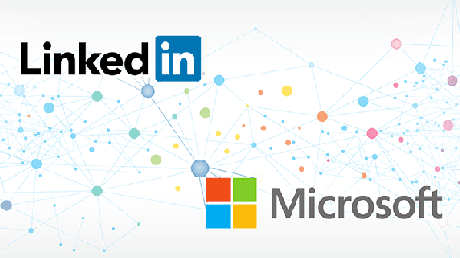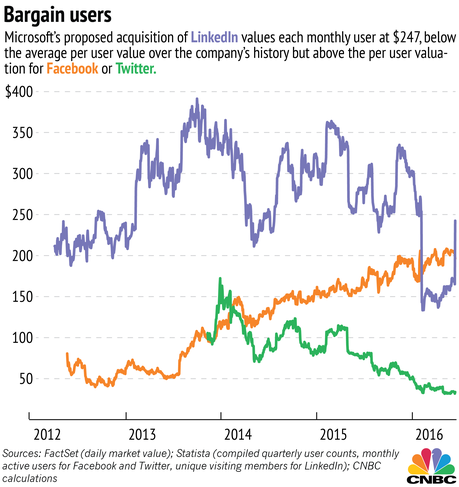Linked In + Microsoft: The End of Office Productivity
My heart sank when I read that Linked In and Microsoft would be merging. "Another tool I'll no longer use," was my initial reaction. Why? Because of the big brother factor. For some non-logical reason, I am OK with LinkedIn "knowing" whom I know, but not OK with Microsoft doing so. And, I'm certainly not OK with Microsoft making suggestions about people who could help me with my current project while I'm using Excel or Word to get things done. That's just creepy.

I also agree with Randall Stross, who wrote in a New York Times Op Ed entitled "Why Linked In Will Make you Hate Microsoft Word" when he quoted and commented on the email Microsoft CEO, Satya Nadella, sent to Microsoft employees:
'This combination will make it possible for new experiences,' [Nadella] wrote, such as 'Office suggesting an expert to connect with via LinkedIn to help with a task you’re trying to complete.' He went on to predict that such experiences would 'get more intelligent and delightful.'
'Delightful' is not the first adjective that comes to mind here, or even the 10th. If I’m working in Word, I can’t see why I’d welcome the intrusion of even a close friend, let alone a bot telling me about a stranger pulled from LinkedIn’s database.
My version of Word, a relatively recent one, is not that different from the original, born in software’s Pleistocene epoch. It isn’t networked to my friends, family and professional contacts, and that’s the point. Writing on Word may be the only time I spend on my computer in which I can keep the endless distractions in the networked world out of sight.
Did Mr. Nadella, who has been at Microsoft since 1992, learn nothing from the Clippy disaster? Clippy, the animated anthropomorphic paper clip introduced in 1996, popped up unbidden in Microsoft Office programs to offer advice. “Are you writing a letter?” it would ask annoyingly. Clippy became famous for the ire it provoked and, in 2010, Time magazine included Clippy in a roundup of the 50 worst inventions of all time, along with asbestos, leaded gasoline and pay toilets."
Randall Stross, New York Times Opinion, June 17, 2016
What's the Benefit for Microsoft & LinkedIn?
That being said, after the kneejerk negative reaction, I looked at the synergies and the logic of the acquistion from the two companies' standpoints and I can see how they seem to make sense:
- Combine LinkedIn's professional network with Microsoft's professional cloud
- Focus on Productivity--white collar work--not leisure/consumer activities
- Use LinkedIn as a single sign on for access to professional resources
LinkedIn CEO, Jeff Weiner's "Synergies List":
- Accelerating our objective to transform learning and development by deeply integrating the Lynda.com/LinkedIn Learning solution in Office alongside some of the most popular productivity apps on the planet (note: 6 of the top 25 most popular Lynda.com courses are related to Microsoft products).
- Realizing LinkedIn’s full potential to truly change the way the world works by partnering with Microsoft to innovate on solutions within the enterprise that are ripest for disruption, e.g., the corporate directory, company news dissemination, collaboration, productivity tools, distribution of business intelligence and employee voice, etc.
- Expanding beyond recruiting and learning & development to create value for any part of an organization involved with hiring, managing, motivating or leading employees. This human capital area is a massive business opportunity and an entirely new one for Microsoft.
- Giving Sponsored Content customers the ability to reach Microsoft users anywhere across the Microsoft ecosystem, unlocking significant untapped inventory.
- Redefining social selling through the combination of Sales Navigator and Dynamics.
- Leveraging our subscription capabilities to provide opportunities to the massive number of freelancers and independent service providers that use Microsoft’s apps to run their business on a daily basis."
Microsoft CEO Satya Nadella has this vision for the combo:
"How people find jobs, build skills, sell, market and get work done and ultimately find success requires a connected professional world. It requires a vibrant network that brings together a professional’s information in LinkedIn’s public network with the information in Office 365 and Dynamics. This combination will make it possible for new experiences such as a LinkedIn newsfeed that serves up articles based on the project you are working on and Office suggesting an expert to connect with via LinkedIn to help with a task you’re trying to complete. As these experiences get more intelligent and delightful, the LinkedIn and Office 365 engagement will grow. And in turn, new opportunities will be created for monetization through individual and organization subscriptions and targeted advertising."
What's the Value of LinkedIn Customers?
I am always interested to know what we're worth to investors. After all, what Microsoft is buying isn't employees and a company; it's that company's customers and the revenues that can be derived from us in the future. The value of what I call: the Customer Franchise (the current + future revenues per customer). Here's a useful chart comparing LinkedIn customer value to that of Facebook and Twitter customers. Of course, many of us are active on all three networks, so OUR value is the combined value of all three (plus any other networks you're active in).

It's interesting to me that CNBC considers this a low per user valuation and looking at the chart, I can see why. You get an even lower number if you divide the 433 million total LinkedIn users into the purchase price of $26.2 billion: $60 per user. To gain some perspective on why these numbers are important and how to think about them, I refer you to my post on the value of Facebook and Twitter customers: Has Twitter Forgotten its Customers? The point I made in that article is that in order to monetize the value of your customers, you have to do more than sell them to advertisers (or, in LinkedIn's case job recruiters)--you need to keep them coming back. That requires actually delivering on the value proposition they signed up for--knowing those customers' moments of truth and how your platform satisfies them. For LinkedIn, the moments of truth that drive most of us to use the platform are: 1) I don't know (enough about) who this person is! 2) I can't find a job! and 3) We're not getting enough clients/customers! Whatever direction Microsoft chooses for LinkedIn's future, if those three needs aren't the top priority, customers will bail.
Bottom Line
This merger isn't about synergies or innovation. It's a way for LinkedIn to return value to its shareholders and payouts to employees before the next financial crash. And it's a way for Microsoft to, once again, try to beat out Google by trying to learn more about the habits and behaviors of its affluent customer base--white collar workers around the globe--and then monetize that knowledge.
I remain skeptical that this merger will do anything to create additional innovation or value.
0 comments
Be the first one to comment.


